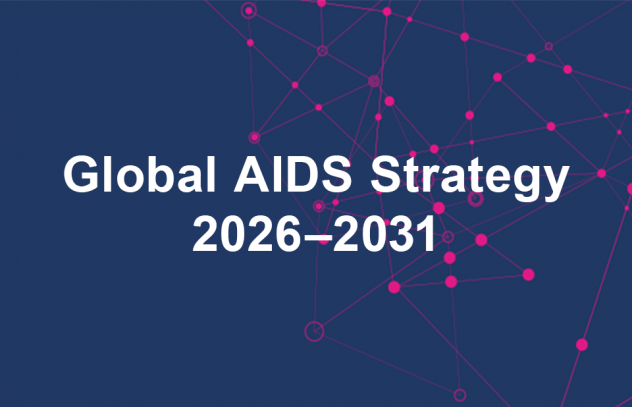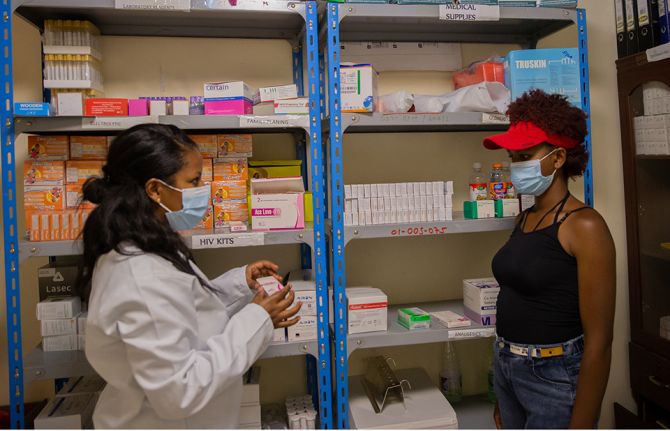
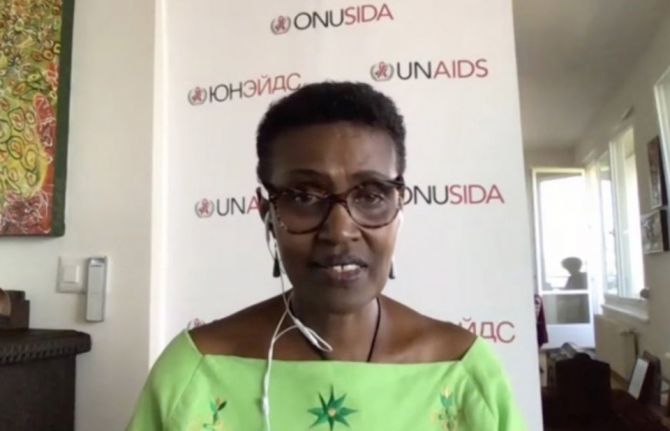
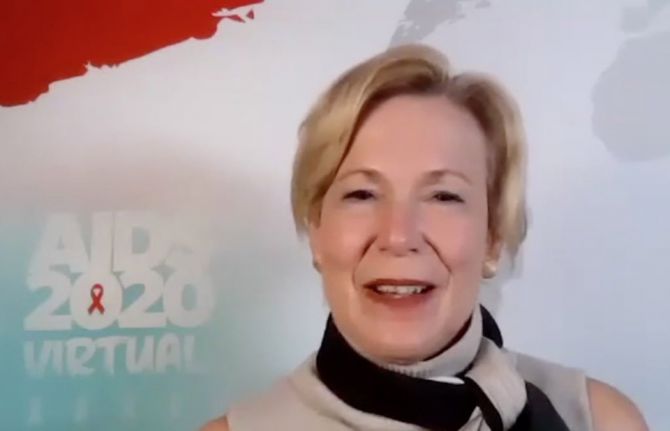
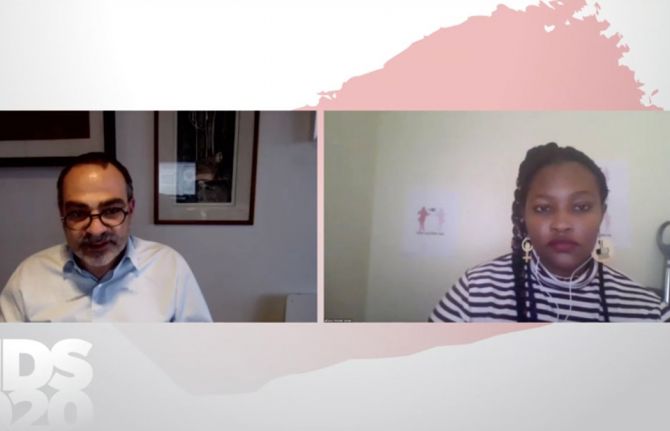
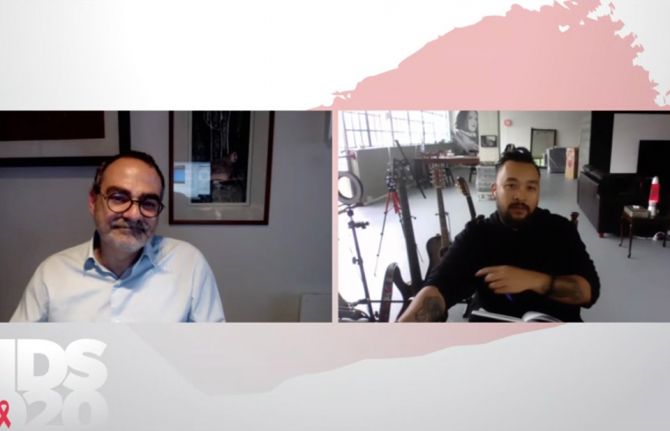
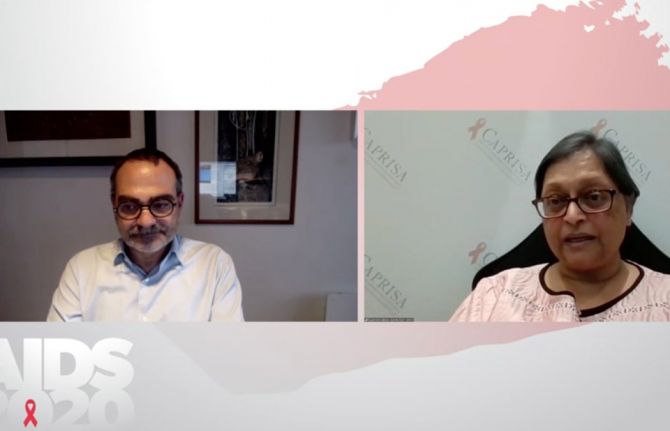
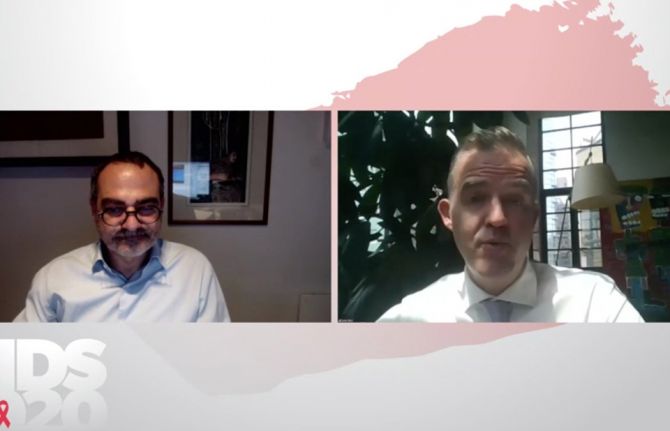
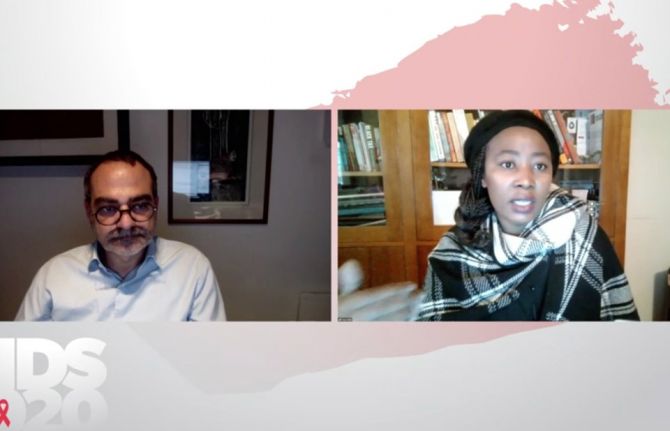
Feature Story
Next global AIDS strategy: be part of making history
09 July 2020
09 July 2020 09 July 2020Opening a session at the 2020 International AIDS Conference on UNAIDS’ next global AIDS strategy, UNAIDS Executive Director Winnie Byanyima presented a bold plan to put the global response to HIV back on track.
“Earlier this week, I raised the alarm that the world will miss the global HIV targets by 2020. The new UNAIDS strategy will be the road map to get the global response back on track to end the AIDS epidemic by 2030,” said Ms Byanyima. “The next UNAIDS strategy must address head-on the areas where we are still lagging, like combination prevention and human rights of key populations, and address the multiple vulnerabilities of adolescent girls and young women in sub-Saharan Africa.”
The session was an opportunity for the participants to engage in a discussion with UNAIDS on the key principles and issues that should underpin the next UNAIDS global AIDS strategy.
Deborah Birx, the United States Global AIDS Coordinator and White House Coronavirus Response Coordinator, stressed the need to “bring data, communities and governments together to address the issues people are confronted with every day.”
The participants agreed on the need for the strategy to address the core vulnerabilities that put people at risk, including harmful traditional gender norms, accessing livelihoods and education and reducing the exclusion and marginalization of key populations.
“Health is not only about health. Health is also about social justice. It's not enough to provide sex workers with condoms without addressing all the factors that prevent them from using them,” said Rico Gustav, Executive Director of the Global Network of People Living with HIV and Chair of the Global Fund Strategy Committee.
To close the gaps, there is a need to apply evidence to design programmes that adapt to the different epidemics and contexts. “We do have the tools to make an impact, but we need to move that to local level. We need to look at more customized solutions,” said Quarraisha Abdool Karim, from the Centre for the AIDS Programme of Research in South Africa.
There was a clear call for communities to be at the centre of the response in order to drive change. At the same time, the participants flagged the need to invest in communities to empower them to claim their leadership role, to hold everyone accountable, to help design and deliver people-centred, rights-based responses to HIV, tuberculosis and COVID-19 and to reach the hard to reach populations.
“How can we have people power when we don’t even have funding,” said Lucy Wanjiku, from the Kenya Positive Young Women Voices.
“Communities must be at the centre of the response. This means being funded, being part of decision-making and opening civic spaces for them to hold us all accountable,” added Ludo Bok, Manager of the Health and Development Group, United Nations Development Programme.
The speakers called for a serious reflection on what must be changed and a collective commitment to change the way we respond to HIV. The participants agreed on the need to focus the conversation on health as a basic right, on health as a social construct. HIV treatment and prevention cannot be delivered if there remain gaps to accessing knowledge, education, health care, harm reduction, sexual and reproductive health, secured livelihoods, economic opportunities, protection from violence and access to justice.
“I feel a renewed sense of urgency. We cannot continue to do the same things and expect a different outcome,” said Ms Byanyima. “People are expecting this strategy to set an urgent new direction for the global AIDS response—for the UNAIDS Joint Programme, for ending AIDS in every country and in every community.”
Related

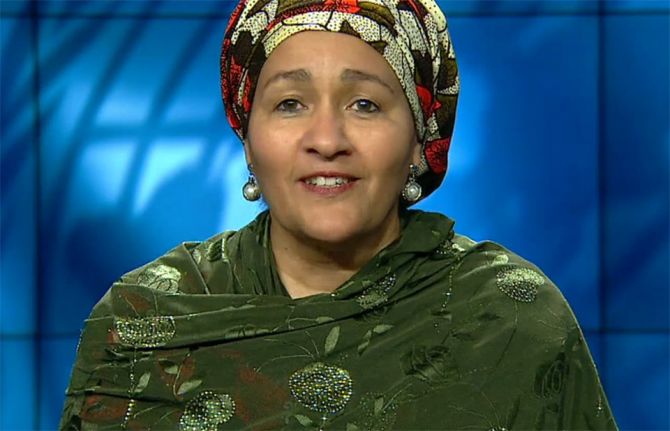
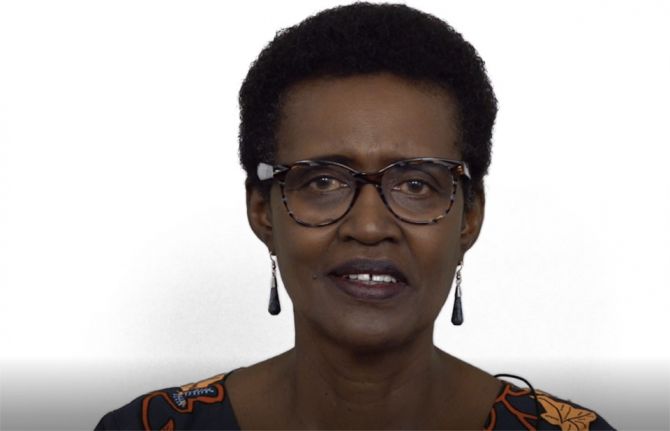
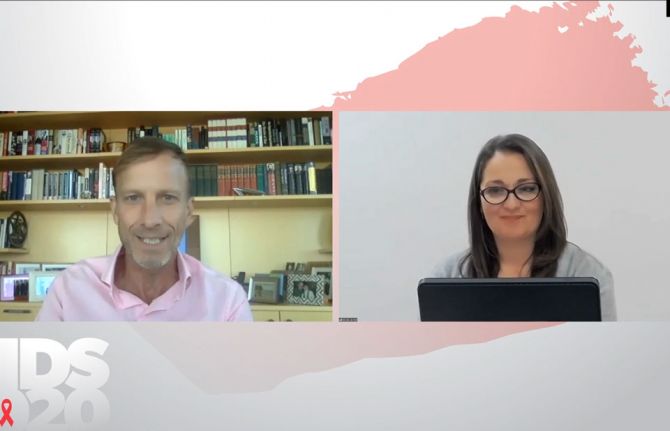
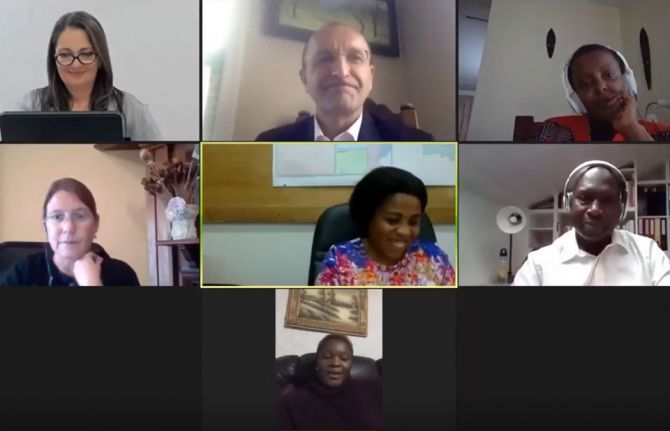
Feature Story
Advancing TB services for people living with HIV during the COVID-19 pandemic
10 July 2020
10 July 2020 10 July 2020The COVID-19 pandemic has spread globally at a speed and magnitude unprecedented in modern times, claiming more than half a million lives and damaging societies and economies. In low- and middle-income countries especially, the COVID-19 pandemic and response is interacting with the global pandemics of tuberculosis (TB) and HIV, creating additional barriers to accessing essential prevention, diagnosis, treatment and care services.
During the opening plenary of the fourth TB/HIV pre-conference of the 2020 International AIDS Conference, the United Nations Deputy Secretary-General, Amina Mohammed, noted that, “COVID-19, like HIV decades before it, and tuberculosis centuries before that, brings into stark reality how inequalities of all types can hollow out our societies, institutions and systems, making us all more vulnerable to health, climate, economic and human security threats. COVID-19 is affecting everyone but not everyone is equally affected.” People must be placed at the centre of the response through rights-based and gender-transformative approaches that also put an end to stigma and discrimination of all types.
TB is the leading infectious cause of death globally and remains the main cause of death among people living with HIV, being responsible for one in three AIDS-related deaths (251 000) in 2018. World Health Organization and UNAIDS estimates suggest that the COVID-19 epidemic and response could cause hundreds of thousands of new HIV infections, a doubling of AIDS-related deaths in sub-Saharan Africa and an additional 6.3 million more TB cases and 1.4 million more TB deaths over the next five years.
The presenters emphasized the need to learn lessons from our experience with the interlinked pandemics of HIV and TB. Rapid transfer of COVID-19 innovations and technology to everyone in need is critical. “Rapid and equitable access to COVID-19 innovations is non-negotiable!” said Winnie Byanyima, UNAIDS Executive Director. “It is imperative that people come before profits, patents and intellectual property. UNAIDS is co-leading the global campaign for a People’s Vaccine to make the COVID-19 vaccine and other technologies patent-free, mass produced, distributed fairly and free at the point of use.”
Over the past decade, billions of dollars have been invested in strengthening health systems infrastructure to deliver TB and HIV services. With the support of civil society and COVID-19 investments this existing infrastructure can be rapidly employed to scale up the COVID-19 response and reach those being left behind while maintaining quality TB and HIV services. TB and HIV civil society organizations are already assisting in finding and testing people with COVID-19 and helping to deliver multimonth supplies of TB and HIV treatment in order to reduce the burden on health-care workers and reduce the risk of transmission of COVID-19.
Few low-income countries would have the capacity to test for COVID-19 without the TB and HIV investments in the multipurpose laboratory testing equipment currently used to diagnose drug-resistant TB and in early infant diagnosis of HIV and monitoring of HIV viral load.
Less than half of all people living with HIV who develop TB disease are diagnosed and treated for both HIV and TB. Increased community testing for COVID-19 provides an opportunity to test for TB and HIV to find the missing millions of cases of TB and HIV in low- and middle-income countries.
While COVID-19 threatens the fragile gains we have made in the HIV and TB response in recent decades, it also offers opportunities to strengthen the response to TB and HIV and systems for health in general.
Ms Byanyima concluded her remarks by saying, “The COVID-19 crisis is a decisive moment for all of us. The right to health has never been higher on the global agenda. This is the time to strengthen the resilience of systems for health and future-proof the health and well-being of generations to come. This is how we will overcome this crisis and finally end AIDS and TB.”
Related
 Government ensures continuity of treatment in Malawi
Government ensures continuity of treatment in Malawi

10 February 2025

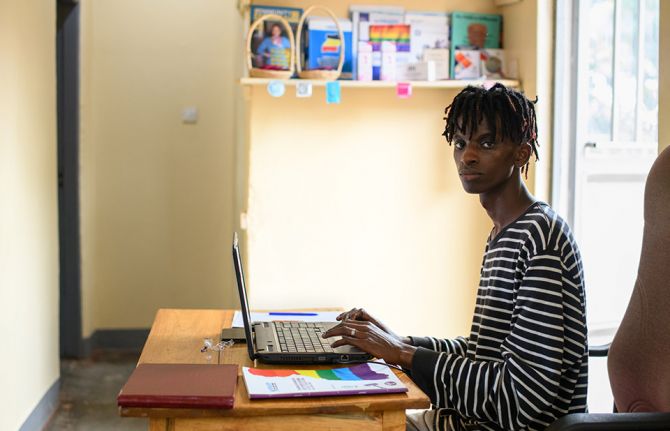
Feature Story
Survey shows that the COVID-19 pandemic increases vulnerability of LGBTI people
10 July 2020
10 July 2020 10 July 2020The opening session of the 2020 International AIDS Conference shared the findings of a rapid online survey demonstrating the increased socioeconomic vulnerability of lesbian, gay, bisexual, transgender and intersex (LGBTI) people due to COVID-19.
UNAIDS, the LGBT+ Foundation and researchers from the Johns Hopkins Bloomberg School of Public Health and other universities around the globe convened a COVID-19 disparities working group. It surveyed more than 20 000 LGBTI people in 138 countries in April and May and found that three quarters (74%) were fully or partially locked down, leading to economic consequences for many.
About 13% of the survey participants have already lost their jobs in the wake of the pandemic and a fifth (21%) are expecting to lose it in the near future. Nearly half the survey participants (47%) faced economic difficulty, with a quarter unable to meet their basic needs, skipping meals or reducing meal sizes.
Of concern, 21% of participants living with HIV reported that they had experienced “interrupted or restricted access” to refills of antiretroviral therapy and 42% of those said they had less than a month’s supply on hand. Worrisome disruptions were also reported for pre-exposure prophylaxis and access to HIV testing. The study also highlights that racial and ethnic minorities consistently have lower access to HIV services.
Erik Lamontagne, Senior Economist at UNAIDS and one of the members of the working group, reported at the conference that the crisis had pushed 1% of respondents to start engaging in sex work and that 2% had to continue to sell sex during the COVID-19 pandemic, risking exposure to the coronavirus. The pandemic has reduced the ability to negotiate safer sex for 13% of respondents, potentially increasing their risk of acquiring HIV. Respondents also reported reduced access to safe injecting equipment and opioid substitution therapy.
“What worries us is that socioeconomic factors, such as limited access to health care, lower income, unemployment and food insecurity, combined with higher anxiety and depression rates, may place some at higher risk of contracting HIV and affect treatment adherence among people living with HIV,” said Mr Lamontagne.
The study shows that COVID-19 increases the vulnerability of groups that are already disproportionately affected by HIV. Solutions and targeted programmes are required from the global community and governments to sustain prevention, testing and treatment services and to help the LGBTI community not only to survive but emerge from the crisis.

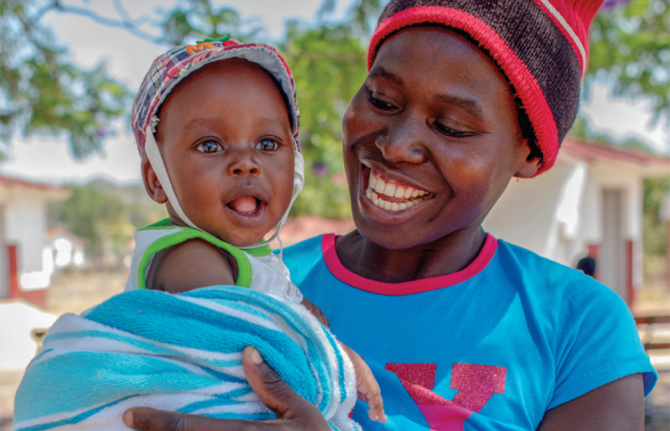
Press Release
Despite great progress since the early days, the HIV response is still failing children
07 July 2020 07 July 2020GENEVA, 7 July 2020—The latest report on the progress towards the Start Free, Stay Free, AIDS Free targets shows that despite great progress made since the early days of the epidemic, the HIV response for children has fallen behind. Year after year, the bold target of eliminating new HIV infections among children is being missed and children are dying needlessly from AIDS-related illnesses—deaths that could be prevented with simple and cheap treatments if the children were diagnosed and treated in time.
“To see so many tools available, so many new HIV infections among children that have been prevented, so many children living with HIV doing well, but to see others missed and still left behind is a tragedy,” said Winnie Byanyima, Executive Director of UNAIDS. “We cannot accept that tens of thousands of children still become infected with HIV and die from AIDS-related illnesses every year.”
The Start Free, Stay Free, AIDS Free framework has three simple concepts. First, babies have a right to enter the world free from HIV. Second, through HIV prevention, children, adolescents and young women have a right to stay free from the virus. Third, children and adolescents who do acquire HIV have the right to be diagnosed, treated and cared for, so that they can remain AIDS-free.
The world’s countries have agreed to a range of HIV prevention and treatment targets. So that children start out their lives HIV-free, one of those targets was to reduce new child (aged 0–14 years) HIV infections to less than 40 000 by 2018 and 20 000 by 2020. However, newly published estimates show that 150 000 children were newly infected with HIV in 2019—a 52% reduction since 2010, but still four times the 2018 target.
By ensuring that pregnant women living with HIV are diagnosed, started on and retained on antiretroviral medicines during pregnancy, delivery and breastfeeding, the chance that they will pass on the virus is less than 1%. Globally, 85% of pregnant women living with HIV received those medicines in 2019. But despite this high coverage, children are still becoming infected due to unequal access to treatment services (primarily in western and central Africa), women falling out of care and pregnant and breastfeeding women becoming newly infected with HIV.
“As a global community, we have made remarkable progress toward controlling the HIV pandemic, yet we are still missing far too many children, adolescents and young women,” said Angeli Achrekar, Principal Deputy United States Global AIDS Coordinator, United States President’s Emergency Plan for AIDS Relief. “We must all redouble our efforts to urgently reach these critical populations—and PEPFAR remains deeply committed to doing its part.”
The stay-free component set a target of reducing new HIV infections among adolescent girls and young women to less than 100 000 by 2020. Adolescent girls and young women have long been disproportionately affected by HIV—among the Start Free, Stay Free, AIDS Free focus countries, adolescent girls and young women make up 10% of the total population but represent 25% of new HIV infections and are at an almost twofold higher risk of HIV infection compared with their male peers. However, new HIV infections among young women have been falling. In South Africa, where combination prevention programmes for adolescent girls and young women are in place, new HIV infections among this age group have dropped by 35%. And in Eswatini, new HIV infections among young women aged 15–24 years have dropped by 54%.
“For too long, the response to HIV has overlooked children, adolescent girls and young women,” said Henrietta Fore, the Executive Director of the United Nations Children’s Fund. “But there is hope. The recent momentum in reducing new infections among adolescent girls and young women in countries like Eswatini and South Africa show us what is possible when governments and communities, led by girls themselves, join forces. We must not let COVID-19 and its economic headwinds slow us down. We must remain bold and ambitious in our joint efforts to ensure that the next generation of children remain free of HIV and AIDS.”
So that children and adolescents stay AIDS-free, countries called for ambitious but achievable targets for HIV treatment for children—to provide 1.4 million children living with HIV with antiretroviral therapy by 2020. In 2019, however, only 950 000 (53%) of the 1.8 million children living with HIV were receiving HIV treatment—much lower than the 67% of adults on treatment. It is clear that to save lives, the missing 840 000 children not on treatment —an estimated two thirds of whom are estimated to be between 5 and 14 years—must be diagnosed and treated as a matter of urgency.
“The lack of optimal HIV medicines with suitable paediatric formulations has been a longstanding barrier to improving health outcomes for children living with HIV, contributing towards low treatment coverage,” said Tedros Adhanom Ghebreyesus, the Director-General of the World Health Organization. “Access to services for vulnerable groups must be expanded through stronger community engagement, improved service delivery and tackling stigma and discrimination.”
Despite the failures, the positive news is that we do know how the world could have met the Start Free, Stay Free, AIDS Free targets. And with enough commitment, we can still overcome the main obstacles to the targets and reverse the failures.
“The past decade has been marked by innovation and progress in the field of paediatric HIV, but the dramatic miss on targets for children in this latest report is simply unacceptable. We must urgently renew our commitment to fighting for an AIDS-free generation, but today, as a global community, we are failing the most vulnerable among us: children and youth,” said Chip Lyons, President and Chief Executive Officer, Elizabeth Glaser Pediatric AIDS Foundation.
“We can do better. We must do better,” added Ms Byanyima. “We know how to save lives and stop new HIV infections among children. I demand that we spare no effort. Anything less is shameful.”
UNAIDS and the United States President’s Emergency Plan for AIDS Relief launched the Start Free, Stay Free, AIDS Free framework in 2016 to build on the achievements of the Global Plan towards the elimination of new HIV infections among children by 2015 and keeping their mothers alive, which ended in 2015.
UNAIDS
The Joint United Nations Programme on HIV/AIDS (UNAIDS) leads and inspires the world to achieve its shared vision of zero new HIV infections, zero discrimination and zero AIDS-related deaths. UNAIDS unites the efforts of 11 UN organizations—UNHCR, UNICEF, WFP, UNDP, UNFPA, UNODC, UN Women, ILO, UNESCO, WHO and the World Bank—and works closely with global and national partners towards ending the AIDS epidemic by 2030 as part of the Sustainable Development Goals. Learn more at unaids.org and connect with us on Facebook, Twitter, Instagram and YouTube.
Contact
UNAIDS GenevaSophie Barton-Knott
tel. +41 79 514 68 96
bartonknotts@unaids.org
UNAIDS Media
tel. +41 22 791 4237
communications@unaids.org
Press centre
Download the printable version (PDF)

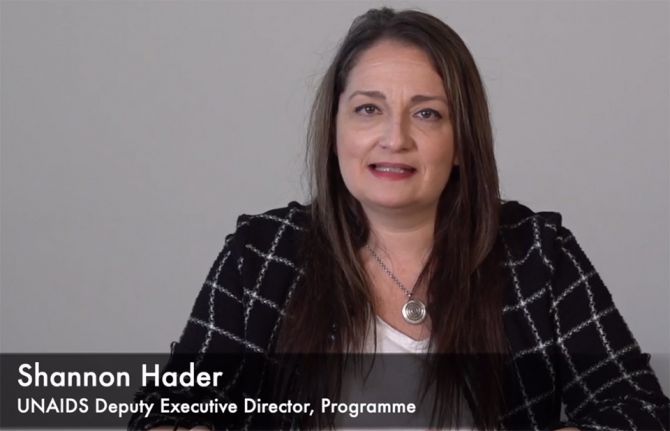
Feature Story
Setting the next generation of goals for the global AIDS response
08 July 2020
08 July 2020 08 July 2020Since the 2020 HIV targets are soon to elapse, UNAIDS is leading a three-year process to develop new targets for 2025 and to estimate the epidemiological impact and the resources needed for the HIV response from 2021 to 2030.
At the 2020 International AIDS Conference, a session chaired by Anton Pozniak, the President of the International AIDS Society, presented the process and main results from the consultations that have informed it, as well as the next steps. It is expected that the targets will inspire countries to develop ambitious national strategic plans and inform discussions in preparation for the United Nations high-level meeting on AIDS in 2021.
“This 2025 target-setting exercise sets itself apart from previous rounds of this work in that it includes a stronger focus on the need for social enablers to achieve targets for the AIDS response, as well as consideration for the integration of HIV services,” said Shannon Hader, UNAIDS Deputy Executive Director, Programme.
Paul De Lay, the Co-Chair of the Steering Committee of the 2025 target-setting process, highlighted that the objective is to focus on what will be needed in 2025 in order to achieve the 2030 goal of ending AIDS as a global public health threat. He stressed the broad participation and transparency of the process, which has included representation from governments, civil society, key populations, academia and others.
A representative of Avenir Health presented the model to be used in the estimation of the impact of the targets. The model includes data on population sizes, the estimated impact of each service included and the effectiveness and sustainability of the interventions.
The session heard presentations from the three co-chairs of the technical consultations on testing and treatment, primary prevention and addressing social enablers.
Wafa El-Sadr, from ICAP at Columbia University, said that according to the results of the technical consultation on testing and treatment, in order to leave no one behind the targets should be the same for all subpopulations, including key populations. There should also be specific targets for men and women adjusted by age group and specifically for children younger than 13 years of age. Pregnant women should have testing and treatment targets higher than 95%.
On primary prevention, Quarraisha Abdool Karim, from the Centre for the AIDS Programme of Research in South Africa, indicated that, globally, new HIV infections have declined, but the rate of the decline was far too slow to reach the 2020 target. HIV prevention requires a context-specific combination approach that includes behaviour, biomedicine and an enabling environment for service access and uptake, and the set of targets for 2025 should call for countries to address structural barriers to services. According to her, most parts of the world are not living up to their commitments to scale up primary prevention services, and so the 2025 targets must include a strong statement on HIV prevention.
On social enablers, the session heard that the response to HIV must be people-centred and be based on the principle of inclusion and participation, highlighting the need for community-led responses.
The target-setting process will feed into the new UNAIDS global AIDS strategy currently being developed.
Related

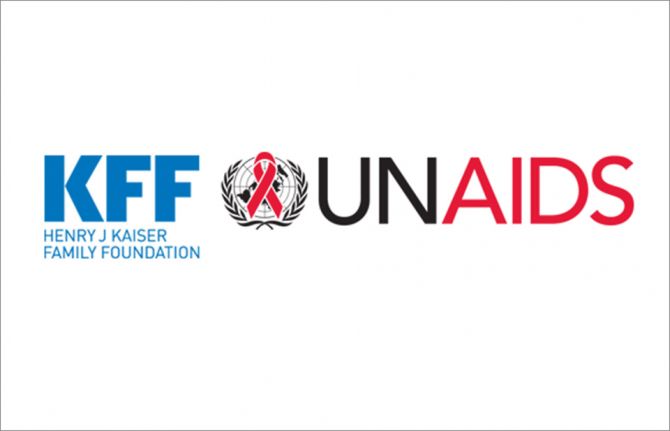
Press Release
KFF/UNAIDS Analysis Finds Donor Governments Spent US$7.8 Billion for HIV in 2019, Down Almost $200 Million From the Previous Year
06 July 2020 06 July 2020Funding from Donor Governments was nearly the same as a Decade Ago, Despite an Increase in the Number of People Living with HIV of 24 percent over that period
GENEVA/SAN FRANCISCO, 6 July 2020—A new report from KFF (Kaiser Family Foundation) and The Joint United Nations Programme on HIV/AIDS (UNAIDS) finds donor government disbursements to combat HIV in low- and middle-income countries totaled US$7.8 billion in 2019, a reduction from the US$8 Billion in 2018 and nearly the same as the funding levels of a decade ago.
Half of the 14 donor governments analyzed in the study decreased their spending on global HIV efforts from 2018 to 2019; six increased; and one held steady. Donor government funding supports HIV care and treatment, prevention and other services in low- and middle-income countries.
The decline in funding was driven primarily by a decrease in bilateral funding from the United States, due to, flat funding from Congress for several years and a shrinking funding pipeline for programs, as well as the timing of disbursements. The decline is also attributable to declining funding from other donors, though to a lesser extent. While donors increased multilateral contributions to The Global Fund to Fight AIDS, Tuberculosis, and Malaria, UNAIDS, and UNITAID by more than $100 million, these gains were not enough to offset declines in bilateral funding. Since 2010, funding from donor governments other than the U.S. has declined by more than US$1 billion largely due to decreased bilateral support for HIV.
Even with its decreased funding, the United States remains the world’s largest donor government to HIV, disbursing US$5.7 billion in 2019, and ranking first in funding relative to the size of its economy. The next largest donor is the United Kingdom (US$646 million), followed by France (US$287 million), the Netherlands (US$213 million) and Germany (US$180 million).
These data feed into the broader UNAIDS global report, which examines all sources of funding for HIV relief, including local governments, non-governmental organizations and the private sector, and compares it the resources need to achieve goals related to testing and treatment. UNAIDS estimates that resources needed by the end of 2020 are US$26.2 billion, compared to US$19.8 billion currently available, leaving a gap of several billion dollars. This gap has grown in recent years as the number of people living with HIV in low and middle income countries has increased by 25% over the past decade and the number of new HIV infections remains high.
“Every dollar not invested today contributes to AIDS-related deaths and new HIV infections,” said Winnie Byanyima, Executive Director of UNAIDS. “In a world characterized by massive inequalities we must ramp up investments for realizing the right to health. It's a shared responsibility, demanding more donor funding and domestic resources, including freeing up fiscal space through debt cancellation.” “Donor governments continue their move away from funding HIV programs in low and middle income countries, while the number of people living with HIV continues to grow,” said KFF Senior Vice President Jen Kates. “This situation is likely to become more precarious in 2020 and beyond, as the effects of COVID-19 hit donor government budgets and take an increasing toll on health and economies around the world.”
The new report, produced as a long-standing partnership between KFF and UNAIDS, provides the latest data available on donor government funding based on data provided by governments. It includes their bilateral assistance to low- and middle-income countries and contributions to the Global Fund, UNAIDS, and UNITAID. “Donor government funding” refers to disbursements, or payments, made by donors.
The Kaiser Family Foundation
KFF is a non-profit organization focusing on national health issues, as well as the U.S. role in global health policy.
UNAIDS
The Joint United Nations Programme on HIV/AIDS (UNAIDS) leads and inspires the world to achieve its shared vision of zero new HIV infections, zero discrimination and zero AIDS-related deaths. UNAIDS unites the efforts of 11 UN organizations—UNHCR, UNICEF, WFP, UNDP, UNFPA, UNODC, UN Women, ILO, UNESCO, WHO and the World Bank—and works closely with global and national partners towards ending the AIDS epidemic by 2030 as part of the Sustainable Development Goals. Learn more at unaids.org and connect with us on Facebook, Twitter, Instagram and YouTube.
Contact
Kaiser Family FoundationNikki Lanshaw
nikkil@kff.org
UNAIDS
Sophie Barton-Knott
tel. +41 79 514 6896/+41 22 791 1697
bartonknotts@unaids.org
Press centre
Download the printable version (PDF)

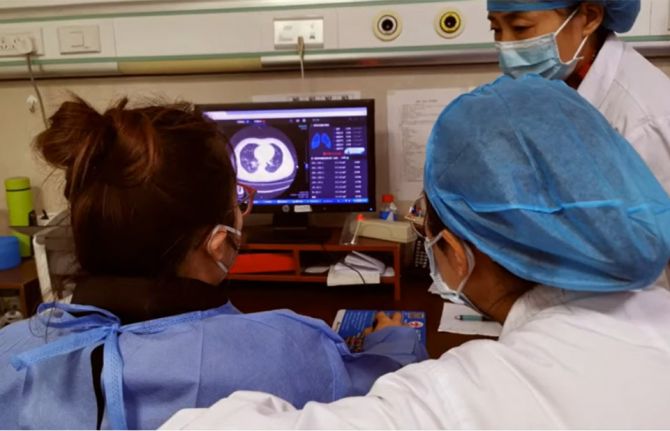
Press Release
UNAIDS Health Innovation Exchange 2020 opens ahead of the International AIDS Conference
01 July 2020 01 July 2020The UNAIDS Health Innovation Exchange’s global event, HIEx2020, will feature health-related innovations from around the world and facilitate discussions around innovation in health
GENEVA, 1 July 2020—The UNAIDS Health Innovation Exchange global event, HIEx2020, has opened, showcasing a virtual marketplace of more than 25 innovations for health from around the world. This year, the event, which is taking place ahead of the 2020 International AIDS Conference, has a special focus on COVID-19.
The innovations presented in the marketplace aim to respond to some of the most critical health challenges faced by countries and communities, particularly in low- and middle-income countries. Innovations range from products to detect counterfeit medicines and illicit substances to digital solutions such as telemedicine platforms that provide remote online medical services, mobile applications to promote the sexual health of young people and COVID-19 diagnostics.
“We need social innovations and to leverage technology to achieve better health outcomes. We need radical game-changers for adolescent girls and young women in sub-Saharan Africa to address persisting inequalities,” said Shannon Hader, Deputy Executive Director, Programme, UNAIDS. “The AIDS response has demonstrated that innovations driven by the passion of communities can transform health-care access and reach the most marginalized.”
One of the featured innovations uses ultraviolet-free LED lighting technology to kill viruses and bacteria, which has recently demonstrated high effectiveness on the new coronavirus that causes COVID-19.
The HIEx2020 programme will run over two days (1 and 2 July) and will feature key leaders in health and innovation. The programme of high-level events includes Lessons from COVID-19: Innovating to Future-Proof our Health Systems, Young People’s Access to Digital Health and Changing Healthcare through Innovations.
Mariya Gabriel, the European Commissioner for Innovation, Research, Culture, Education and Youth, will deliver a keynote address focused on leveraging innovation and leadership for global health. “Innovation must be part of the health-care DNA, leaving no one behind,” said Ms Gabriel. “But no individual continent, country or institution can win this race on its own. It takes a global effort and political commitment.”
HIEx2020 will feature a special spotlight on solar energy for health through a high-level discussion with ministers of health and energy from several countries, which is organized in collaboration with the International Solar Alliance. Primary health facilities in several countries lack reliable power, which not only limits quality of services but also prevents the take-up of digital health tools for scaling up access to health care.
“Solar energy can ensure better availability and quality of health services in areas where there is a challenge of access to energy,” said Upendra Tripathy, the Director-General of the International Solar Alliance. “We should work towards scaling up solar energy as an agent for transforming primary health care in developing countries.”
Innovations for COVID-19
The COVID-19 pandemic has brought to light the crucial importance of ensuring that health systems are resilient and that countries have the necessary technologies and capacities to respond effectively to health crises.
The UNAIDS Health Innovation Exchange has been an early supporter of tracking COVID-19-related innovations. As the COVID-19 pandemic was rapidly spreading in March 2020, UNAIDS and the UNAIDS Health Innovation Exchange teamed up with StartupBlink to launch a dynamic online map of COVID-19-related innovations. The map now has more than 30 000 monthly users and includes details of more than 1000 initiatives from around the world. As part of HIEx2020, the UNAIDS Health Innovation Exchange and StartupBlink will launch an in-depth analysis of the COVID-19 initiatives in an Innovation Ecosystem Report, which will measure and rank cities and countries globally in terms of innovation for COVID-19.
To visit HIEx2020 go to: https://event.healthinnovation.exchange/
UNAIDS Health Innovation Exchange
Launched by UNAIDS in Geneva, Switzerland, in May 2019, the UNAIDS Health Innovation Exchange identifies challenges faced by implementers and connects them with innovations that have high potential for impact, and links with investors to scale up the sustainable solutions. The UNAIDS Health Innovation Exchange builds upon the expertise of political leaders, health experts, technology and science leaders, innovators, investors, accelerators, communities and implementers in countries, and advocates for indigenous solutions, local production and multisectoral partnerships.
Note: inclusion in the UNAIDS Health Innovation Exchange marketplace does not equal endorsement of the innovation by UNAIDS or the UNAIDS Health Innovation Exchange.
UNAIDS
The Joint United Nations Programme on HIV/AIDS (UNAIDS) leads and inspires the world to achieve its shared vision of zero new HIV infections, zero discrimination and zero AIDS-related deaths. UNAIDS unites the efforts of 11 UN organizations—UNHCR, UNICEF, WFP, UNDP, UNFPA, UNODC, UN Women, ILO, UNESCO, WHO and the World Bank—and works closely with global and national partners towards ending the AIDS epidemic by 2030 as part of the Sustainable Development Goals. Learn more at unaids.org and connect with us on Facebook, Twitter, Instagram and YouTube.
Learn more

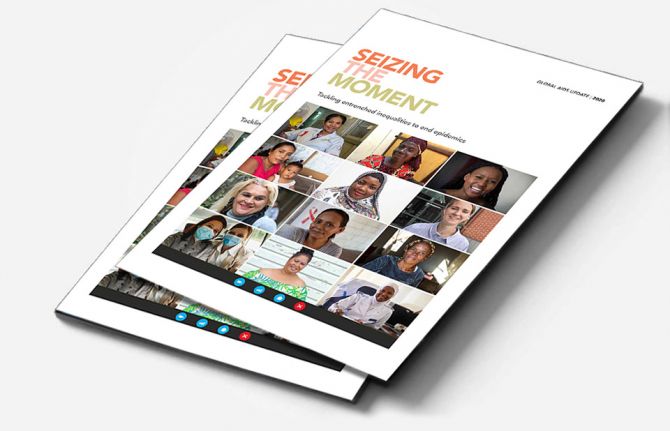
Press Release
UNAIDS report on the global AIDS epidemic shows that 2020 targets will not be met because of deeply unequal success; COVID-19 risks blowing HIV progress way off course
06 July 2020 06 July 2020Missed targets have resulted in 3.5 million more HIV infections and 820 000 more AIDS-related deaths since 2015 than if the world was on track to meet the 2020 targets. In addition, the response could be set back further, by 10 years or more, if the COVID-19 pandemic results in severe disruptions to HIV services.
GENEVA, 6 July 2020—A new report by UNAIDS shows remarkable, but highly unequal, progress, notably in expanding access to antiretroviral therapy. Because the achievements have not been shared equally within and between countries, the global HIV targets set for 2020 will not be reached. The report, Seizing the moment, warns that even the gains made could be lost and progress further stalled if we fail to act. It highlights just how urgent it is for countries to double down and act with greater urgency to reach the millions still left behind.
“Every day in the next decade decisive action is needed to get the world back on track to end the AIDS epidemic by 2030,” said Winnie Byanyima, the Executive Director of UNAIDS. “Millions of lives have been saved, particularly the lives of women in Africa. The progress made by many needs to be shared by all communities in all countries. Stigma and discrimination and widespread inequalities are major barriers to ending AIDS. Countries need to listen to the evidence and step up to their human rights responsibilities.”
Fourteen countries have achieved the 90–90–90 HIV treatment targets (90% of people living with HIV know their HIV status, of whom 90% are on antiretroviral treatment and of whom 90% are virally supressed), including Eswatini, which has one of the highest HIV prevalence rates in the world, at 27% in 2019, and which has now surpassed the targets to achieve 95–95–95.
Millions of lives and new infections have been saved by the scale-up of antiretroviral therapy. However, 690 000 people died of AIDS-related illnesses last year and 12.6 million of the 38 million people living with HIV were not accessing the life-saving treatment.
“We cannot rest on our successes, nor be discouraged by setbacks. We must ensure that no one is left behind. We must close the gaps. We are aiming for 100–100–100,” said Ambrose Dlamini, the Prime Minister of Eswatini.
The world is far behind in preventing new HIV infections. Some 1.7 million people were newly infected with the virus, more than three times the global target. There has been progress in eastern and southern Africa, where new HIV infections have reduced by 38% since 2010. This is in stark contrast to eastern Europe and central Asia, which has seen a staggering 72% rise in new HIV infections since 2010. New HIV infections have also risen in the Middle East and North Africa, by 22%, and by 21% in Latin America.
Seizing the moment shows unequal progress, with too many vulnerable people and populations left behind. Around 62% of new HIV infections occurred among key populations and their sexual partners, including gay men and other men who have sex with men, sex workers, people who inject drugs and people in prison, despite them constituting a very small proportion of the general population.
Stigma and discrimination, together with other social inequalities and exclusion, are proving to be key barriers. Marginalized populations who fear judgement, violence or arrest struggle to access sexual and reproductive health services, especially those related to contraception and HIV prevention. Stigma against people living with HIV is still commonplace. At least 82 countries criminalize some form of HIV transmission, exposure or non-disclosure, sex work is criminalized in at least 103 countries and at least 108 countries criminalize the consumption or possession of drugs for personal use.
Women and girls in sub-Saharan Africa continue to be the most affected and accounted for 59% of all new HIV infections in the region in 2019, with 4500 adolescent girls and young women between 15 and 24 years old becoming infected with HIV every week. Young women accounted for 24% of new HIV infections in 2019, despite making up only 10% of the population in sub-Saharan Africa.
However, where HIV services are comprehensively provided, HIV transmission levels are reduced significantly. In Eswatini, Lesotho and South Africa, a high coverage of combination prevention options, including social and economic support for young women and high levels of treatment coverage and viral suppression for previously unreached populations, have narrowed inequality gaps and driven down the incidence of new HIV infections.
The COVID-19 pandemic has seriously impacted the AIDS response and could disrupt it more. A six-month complete disruption in HIV treatment could cause more than 500 000 additional deaths in sub-Saharan Africa over the next year (2020–2021), bringing the region back to 2008 AIDS mortality levels. Even a 20% disruption could cause an additional 110 000 deaths.
“Those of us who survived HIV and fought for life and access to treatment and care cannot afford losing the gains that took so much effort to win. In some Latin American countries we are seeing how HIV resources, medicines, medical staff and equipment are being moved to the fight against COVID-19,” said Gracia Violeta Ross, President of the Bolivian Network of People Living with HIV. “Some good lessons and practices of the HIV response, such as meaningful participation and accountability, are being ignored. We will not allow HIV to be left behind.”
To fight the colliding epidemics of HIV and COVID-19, UNAIDS and partners are leading a global call for a People’s Vaccine for COVID-19, which has been signed by more than 150 world leaders and experts demanding that all vaccines, treatments and tests be patent-free, mass produced and distributed fairly and free for all.
UNAIDS is also urging countries to increase investments in both diseases. In 2019, funding for HIV fell by 7% from 2017, to US$ 18.6 billion. This setback means that funding is 30% short of the US$ 26.2 billion needed to effectively respond to HIV in 2020.
“We cannot have poor countries at the back of the queue. It should not depend on the money in your pocket or the colour of your skin to be protected against these deadly viruses,” said Ms Byanyima. “We cannot take money from one disease to treat another. Both HIV and COVID-19 must be fully funded if we are to avoid massive loss of life.”
UNAIDS
The Joint United Nations Programme on HIV/AIDS (UNAIDS) leads and inspires the world to achieve its shared vision of zero new HIV infections, zero discrimination and zero AIDS-related deaths. UNAIDS unites the efforts of 11 UN organizations—UNHCR, UNICEF, WFP, UNDP, UNFPA, UNODC, UN Women, ILO, UNESCO, WHO and the World Bank—and works closely with global and national partners towards ending the AIDS epidemic by 2030 as part of the Sustainable Development Goals. Learn more at unaids.org and connect with us on Facebook, Twitter, Instagram and YouTube.
Contact
UNAIDS GenevaSophie Barton-Knott
tel. +41 22 791 1697 / +41 79 514 6896
bartonknotts@unaids.org
UNAIDS Media
tel. +41 22 791 4237
communications@unaids.org
Press centre
Download the printable version (PDF)

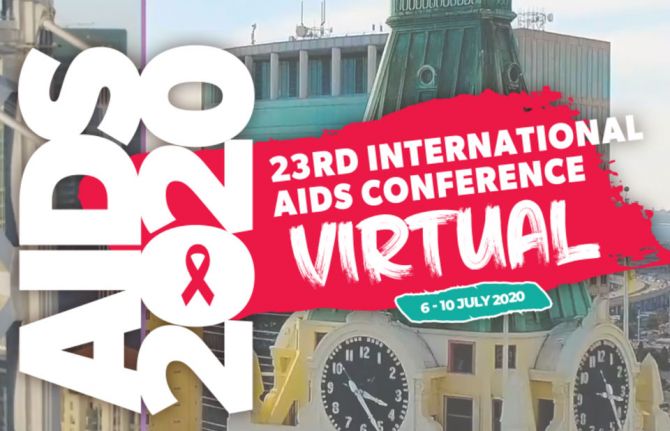
Press Statement
UNAIDS supports decision to hold the 23rd International AIDS Conference virtually, hopes that HIV2020 can be held in some form
27 March 2020 27 March 2020GENEVA, 27 March 2020—UNAIDS welcomes the decision by the International AIDS Society to hold the 23rd International AIDS Conference in July as a virtual gathering and hopes that the key population networks organizing the HIV2020 conference can find an alternative solution to hold their conference.
In the light of the COVID-19 pandemic, AIDS 2020: Virtual, organized by the International AIDS Society, will enable the participants to access and engage with the latest HIV science, advocacy and knowledge, and to do so safely.
The organizers of HIV2020, a conference that was due to be held in Mexico in order to provide a safe alternative for people who cannot or will not enter the United States of America, have cancelled the conference and will look at alternative arrangements after the Government of Mexico suspended large events in the country.
“I thank the organizers for going ahead with the 2020 International AIDS Conference, and in a way that will protect the lives and well-being of the thousands of participants. I call on people to get together at AIDS 2020: Virtual in greater numbers than ever before and recommit to working together to end the AIDS epidemic,” said Winnie Byanyima, UNAIDS Executive Director. “I hope that HIV2020 can still go ahead in some form and UNAIDS supports the decision of the co-organizers to put the health and safety of communities first.”
Large numbers of people had been expected to attend AIDS 2020 in San Francisco and Oakland, United States. Instead, AIDS 2020: Virtual will allow the participants to engage in virtual sessions, satellites, exhibitions, podcasts and interactive community networking from anywhere in the world. It is hoped that HIV2020 will be held in a similar way.
Kevin Osborne, the Executive Director of the International AIDS Society (IAS), said, “The AIDS 2020: Virtual theme is resilience. There is no better word to describe what’s needed at this time. For today, this resilience is being tested by a rapidly evolving global health landscape, to which we must now add the COVID-19 pandemic. In solidarity, now more than ever the HIV community needs to come together in our shared commitment to ensure that evidence and human rights remain cornerstones of our response.”
Rico Gustav, the Executive Director of the Global Network of People Living with HIV (GNP+), said, “As co-organizers of HIV2020, the Global Network of People Living with HIV and other global networks are unanimous in our decision to cancel the conference. The health and safety of our communities comes first. As COVID-19 affects more countries and communities, we are adapting and supporting our members in these extremely difficult times. The HIV2020 co-organizers will continue to defend and enhance the leadership of key populations and people living with HIV for HIV and health responses locally, nationally and globally, including exploring virtual spaces to enable this.”
UNAIDS urges everyone to remember that COVID-19 is a serious disease. All people living with HIV should take all recommended preventive measures to minimize exposure to, and prevent infection by, the virus that causes COVID-19.
As in the general population, older people living with HIV or people living with HIV with heart or lung problems may be at a higher risk of becoming infected with the virus and of suffering more serious symptoms. We will learn more about how HIV and COVID-19 together impact on people living with HIV from countries and communities responding to both epidemics. Lessons in rolling out innovations or adapting service delivery to minimize the impact on people living with HIV will be shared and replicated as they become available.
The HIV response has shown that strong and effective public health response that engage affected communities must be based on human rights and address both the biological and social contexts of the diseases. As COVID-19 moves into high-density settings and threatens marginalized people and communities, it is critical that information needs, basic hygiene supplies such as soap and water, sufficient food and social supports that respond to income loss and poverty are prioritized and addressed as part of preparation and response.
“The COVID-19 pandemic is affecting the lives of billions of people around the world,” added Ms Byanyima. “We must not forget, however, that the HIV epidemic has not gone away. Even in these difficult times, our partners are making sure that the AIDS response carries on—unsung heroes are ensuring that HIV treatment and prevention services for people living with and affected by HIV continue to be available.”
UNAIDS
The Joint United Nations Programme on HIV/AIDS (UNAIDS) leads and inspires the world to achieve its shared vision of zero new HIV infections, zero discrimination and zero AIDS-related deaths. UNAIDS unites the efforts of 11 UN organizations—UNHCR, UNICEF, WFP, UNDP, UNFPA, UNODC, UN Women, ILO, UNESCO, WHO and the World Bank—and works closely with global and national partners towards ending the AIDS epidemic by 2030 as part of the Sustainable Development Goals. Learn more at unaids.org and connect with us on Facebook, Twitter, Instagram and YouTube.
Contact
UNAIDS GenevaSophie Barton-Knott
tel. +41 79 514 68 96
bartonknotts@unaids.org
UNAIDS Media
tel. +41 22 791 4237
communications@unaids.org
AIDS2020
Press centre
Download the printable version (PDF)

